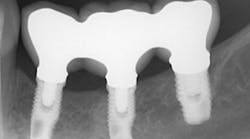Nancy Case Study: Communicating with the Lab [Part II]
Continuing the discussion on the Nancy Case Study, this article will highlight the lab communication phase that began in Part I.
A critical part in the lab communication for Nancy was contour and alignment. The tooth reduction was done after bonding a mock-up in place to produce an even thickness of restorative material on the facial of both centrals. When I had everything adjusted, prior to cementing the temps, I took calipers and measured the thickness of both central temporaries from mesial to distal across the facial surface, with the right being 1.1mm and the left being 1mm thick.
Additionally, the temporaries had an even color across the facial surface when in place, indicating minimal show through from the underlying preps that is quite common when there is inadequate reduction. But if the technician attempts to straighten out the alignment of the restorations by pulling the distals in, they run the risk of the restorations becoming extremely thin and getting show through of the underlying preps in the final ceramic. To prevent this I made a special note that the temporaries measured 1mm in thickness across the facial surface, and the final restorations should be also.
When picking materials for Nancy, one thing the technician didn’t have to worry about was strength. Nancy showed no signs of any occlusal issues, which meant the focus could be on choosing a material that would look the best esthetically. In addition it was important for the technician to realize that even though my margins are subgingival, Nancy’s tissue is fairly thin. This means I don’t want any materials used that have an opaque core at the margin as it would probably show through as a bright line. The good news is that her tooth preparation color isn’t that dark, so a more translucent material can be used.
And finally, I asked the technician to choose the material based upon what they believed would produce the best result, given the prep color, margin placement, tooth reduction, and desired shade. I am a firm believer that technicians know what materials work best in their hands for different cases and clinical situations, and it may be very different for different technicians, but as long as strength isn’t a big concern, I will let them pick the actual material used.
What I know is the material chosen does not have the biggest impact on the final outcome, it is the ability of the technician to know and work with the material, having adequate space for the material, and getting excellent laboratory communication that determines the final result.
Reprinted with permission from Spear Education.







